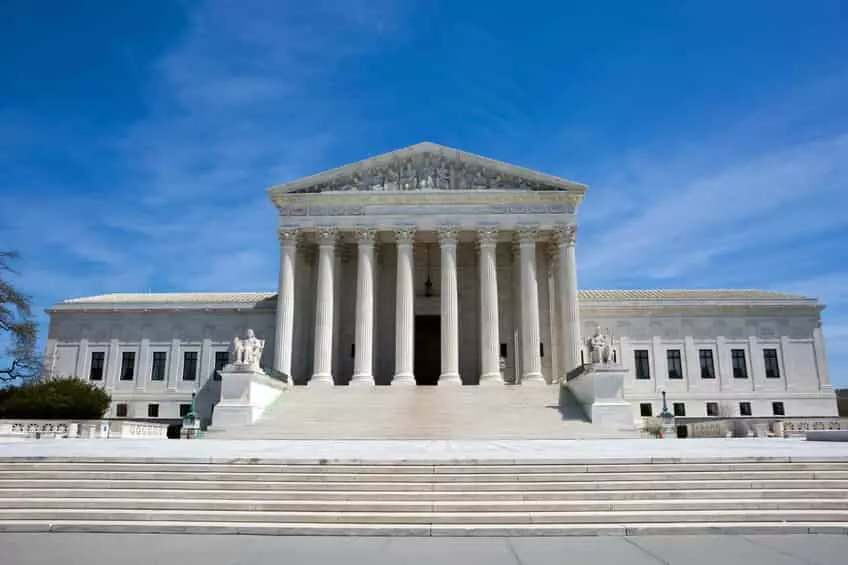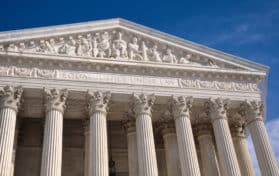
The Supreme Court has been called “the final arbiter of the law.” Chief Justice Charles Evan Hughes once said, regarding the highest court of the land, “The republic endures and this is the symbol of its faith.” The Supreme Court of the United States is the highest court in the United States, and it is intended to be the final say in all cases regarding the Constitution as well as legalities in the country. The Supreme Court is intended to provide “equal justice under the law,” which is engraved in the main entrance of the Supreme Court building.
High school civics classes teach us that the Supreme Court is made up of individuals who may serve the country either until retirement or death. No other position allows for a person to serve a lifetime, if the individual chooses to do so. Therefore, choosing Supreme Court justices is a careful process that can never be taken lightly. Justices are expected to interpret the Constitution in order to provide fair rulings on a number of cases. The Supreme Court was originally a group of six justices, but the Judiciary Act of 1869 brought the number of justices to nine. Since 2017, many new justices have been confirmed to a position on the Supreme Court. Yet the average American many not understand exactly what goes into the process of confirming a new Supreme Court justice. Let’s take a look at the process.
What are the qualifications for becoming a Supreme Court justice?
Most modern justices have a background in the law. Both (current) Justices Gorsuch and Kavanaugh clerked under former Justice Andy Kennedy. Many justices have served on federal courts prior to their appointment to the bench. However, the Constitution does not specify that Supreme Court justices be attorneys nor do they have to have graduated from law school.
In addition, the Constitution does not provide guidance for choosing Supreme Court justices based on age, profession, citizenship, or education. However, the last justice that had not attended law school was appointed in 1941. That justice was James F. Byrnes, and he did not complete high school. However, Justice Byrnes educated himself. He did, however, pass the bar exam. Prior to the twentieth century, there were only a few law schools, so most attorneys trained under a mentor.
So what does the Constitution say about Supreme Court justices?
Article III, Section One of the Constitution only details the roles of Supreme Court justices. Section One only states that “Judges, both of the supreme and inferior Courts, shall hold their Offices during good Behaviour.” The Section finishes by saying that the justices should be compensated for their services, and that the compensation “shall not be diminished” during their time in office.
What is Sheldon Goldman’s list of eight criteria for Supreme Court justices?
(Sheldon Goldman is a political science scholar who taught at UMass. He also wrote the 1997 book Picking Federal Judges.)
Since the Senate confirms each justice, justices today typically do have a background in law. When a president is considering potential nominees for the Supreme Court, they typically – but are not required to – utilize these criteria in selecting a justice:
- the individual’s potential for neutrality when making legal decisions
- the individual’s record of being fair-minded
- the individual’s knowledge of the law
- the individual’s ability to think as well as write logically
- the integrity of the individual
- the health – both mental and physical – of the potential justice
- the individual’s temperament while presiding over cases
- the individual’s potential for handling judicial power responsibly
What is the process that the president goes through to nominate a Supreme Court justice?
Article II, Section 2 of The Constitution states that presidents are assigned the role of nominating a justice, but presidents must do so “with the Advice . . .of the Senate.” So, before the president ever announces a potential nominee, he will consult with members of the Senate. The president typically considers the legal background of the potential nominee as well as the individual’s potential to be a fair-minded and logically-thinking justice.
Most of the time, the president nominates a justice that shares his political ideology. There is nothing in the Constitution that requires this, but it is highly important to most presidents that any nominees they propose for lower federal courts as well as the Supreme Court share their political beliefs, at least somewhat.
What happens once the president announces his pick to fill a Supreme Court vacancy?
Once the candidate’s name has been announced, the Senate Judiciary Committee takes over. This committee will begin to gather information on the candidate. This includes personal background information, work history, and an FBI investigation. Typically, the FBI gathers information pertaining to the nominee’s “suitability” for the job. This includes collecting information on the nominee’s financial, employment, and academic life; however, the Federal Bureau of Investigation does not make a decision on the candidate’s credibility. They simply gather facts; they may even speak to neighbors and/or family members of the candidate. Once the FBI concludes its investigation, the agency drafts a report of findings and presents it to the president. The president then turns this information over to Senate to be utilized in their confirmation hearings.
What happens during a Senate confirmation hearing?
The Senate typically calls witnesses who both support and oppose the individual’s nomination. The members of the Senate Judiciary Committee also question the individual regarding his or her qualifications, judicial philosophy, and other various topics. Once the Judiciary concludes its hearing process, the committee votes on whether the individual should be confirmed to the justice position. If the committee votes to recommend the individual to the entire Senate for confirmation, then that is the next step in the confirmation process.
How did the “nuclear option” change the way the Senate votes on Supreme Court justices?
In April 2017, then-President Donald Trump appointed the well-qualified and highly uncontroversial candidate, Neil Gorsuch, as his first nominee to the Supreme Court. At that time, the Senate allowed for unlimited debate (called the filibuster) when discussing the potential nominee. Prior to 2017, only a 3/5 vote of the Senate (sixty votes) could stop the filibuster and bring about a vote on the nominee. Changing the rules for this, which is called the “nuclear option” and is only valid during the confirmation process, took place under the leadership of then-Senate Majority Leader Mitch McConnell (R-KY).
Now, Supreme Court justices are voted on utilizing a simple majority. A nominee must have at least 51 votes in order to be confirmed. In the case of a 50 – 50 vote, the Vice President can be brought in to break the tie.
In 2017, when the nuclear option was utilized during the Gorsuch nomination, Justice Gorsuch was confirmed by a vote of 54 – 45. Democratic Senators Joe Manchin, Heidi Heitkamp and Joe Donnelly all voted with Republican Senators to confirm Gorsuch.
Summary
While the Constitution established the Supreme Court, the document did not lay out specific qualifications for the post. However, political science scholars over time have come up with some guidelines that a president may use when considering a potential nominee.
Once the president has a nominee in mind, he should consult with members of the Senate prior to the nomination. The Constitution does require that the president utilize the “advice” of the Senate. It also requires that the “consent” of the Senate be used in the confirmation process.
Once the nominee has been named, the Senate takes about one month to investigate the nominee. The FBI assists in the investigation. The FBI draws up a report on their findings, and they submit this to the president, who will share the report with the Senate Judiciary Committee. The Judiciary holds hearings as a part of the confirmation process. Once the hearing is over, the committee then makes a recommendation to the entire branch of the Senate regarding the candidate.
The Senate typically debates the nominee’s confirmation. Prior to 2017, the Senate was allowed unlimited debate. The only way to stop the debate was for a vote of at least sixty senators agreeing to confirm the nominee. In April 2017, Senate Majority Leader Mitch McConnell invoked the nuclear option, which changed the vote to a simple majority of fifty-one votes, in order to hold a vote on then-nominee Neil Gorsuch.





